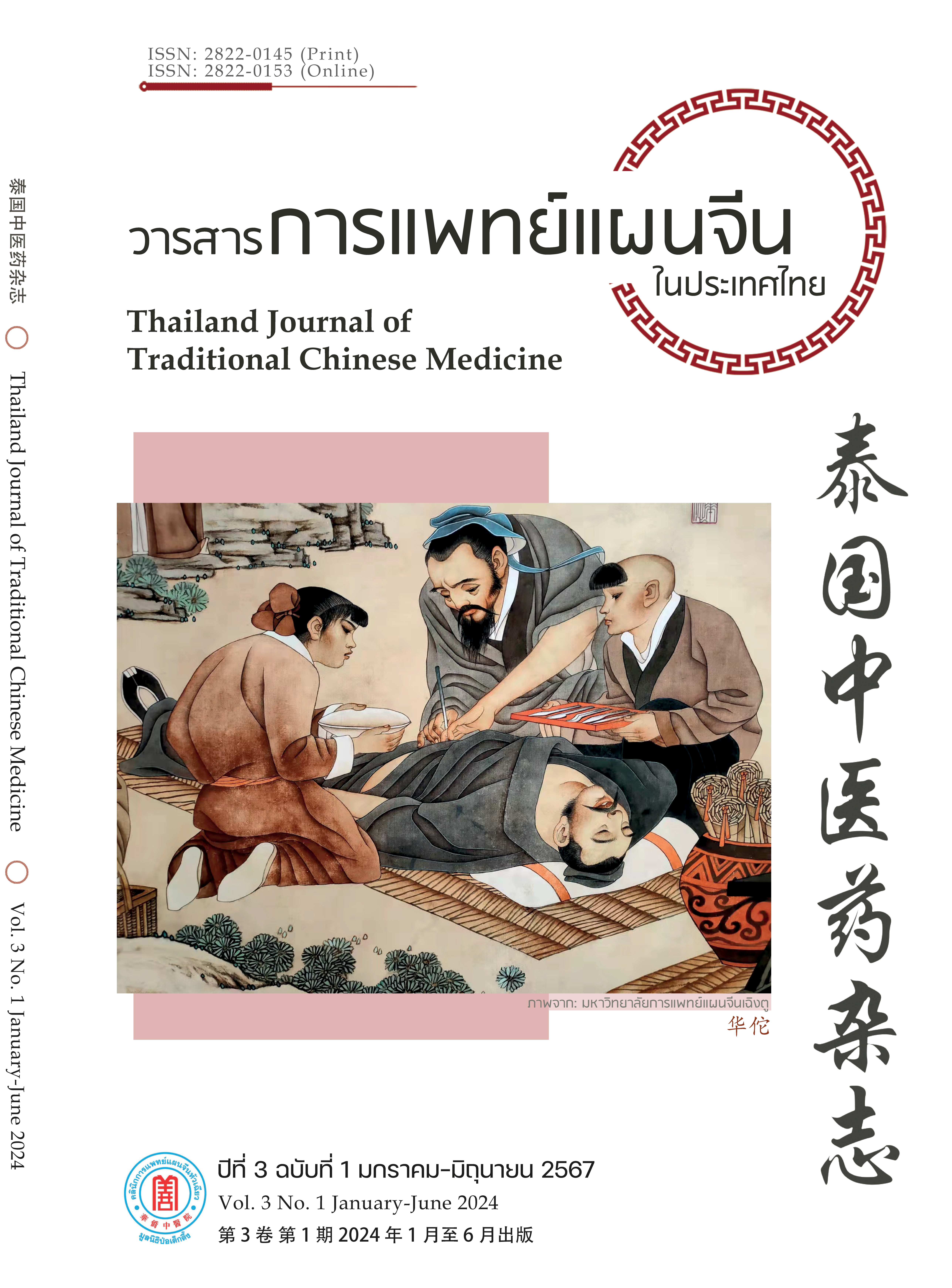Research progression on the treatment of menopausal insomnia in women with traditional Chinese medicine
Main Article Content
Abstract
Menopausal insomnia is a prevalent condition that affects middle-aged and elderly women. It has a significant impact on their physical and mental wellness, general well-being, and ability to cope with stress. It also disrupts normal brain function and increases the risk of developing hypertension and heart disease. Traditional Chinese medicine (TCM) provides a wide range of therapeutic options for this condition, including TCM decoctions, ready-made TCM formulations, acupuncture, moxibustion, massage, and medicinal baths. Furthermore, TCM has been demonstrated to have substantial advantages in alleviating menopausal insomnia. Patients receiving TCM therapy report minimal negative side effects and have positive therapeutic results. This study examines recent research to synthesize several TCM methods for menopausal insomnia treatment, offering important new understandings of the TCM approach to managing this medical condition.
Article Details
References
Wu MH. TCM internal medicine. Beijing: China Press of Traditional Chinese Medicine; 2012. (in Chinese)
Zhang XP, Yang MX, Zhang SZ, Zheng HB. Theory discussion and clinical application of insomnia in Huangdi Neijing. China Journal of Traditional Chinese Medicine and Pharmacy. 2019;34(12):5765-7. (in Chinese)
Han QN, Chen BH, Zhu HL. Comparison of treatment ideas between traditional Chinese medicine and Western medicine for insomnia in perimenopausal women. Hainan Medical Journal. 2023;34(1):148-52. (in Chinese)
Li TS, Li B, Liu ZL. Traditional Chinese medicine research progress on perimenopausal insomnia. Chinese and Foreign Medical Research. 2023;21(8):158-61. (in Chinese)
Li XH, Tang L, Yan QY, Fu XM. Exploring the changes in pathogenesis of "heart Yin deficiency heat" and exploring the treatment of Chinese medical master Xiao Chengjun experience of menopausal insomnia. Chinese Clinical Doctor. 2023;51(9):1130-2. (in Chinese)
Zhao JB, Wang QG, Chen CA, Zhang NF, Li G, Cheng FF, et al. TCM master Wang Qingguo's treatment of menopausal insomnia from the viewpoint of "discord of tai and shao". Acta Chinese Medicine. 2022;37(12):2613-7. (in Chinese)
Dong N, Zhang DH, Wen XC, Jing PW. Director Zhang Dinghua’s experience in treating female climacteric insomnia. Clinical Journal of Chinese Medicine. 2022;14(9):50-2. (in Chinese)
Sun M, Xue S. Xue Sha’s clinical experience in treating menopausal insomnia. Clinical Journal of Traditional Chinese Medicine. 2018;30(1):53-5. (in Chinese)
Hu LP. Effect of Huanglian Ejiao decoction combine with Ganmai Dazao decoction in the treatment of menopausal insomnia. Inner Mongol Journal of Traditional Chinese Medicine. 2019;38(12):49-50. (in Chinese)
Cai Y, Ye YM, Zhang T, Yang W, Wang GY, Shi W. Clinical efficacy of modified Guizhi Gancao Longgu Muli Tang in treating menopausal insomnia and its effect on sleep quality and neurotransmitter. Chinese Journal of Experimental Traditional Medical Formulae. 2019;25(9):38-42. (in Chinese)
Liu J, Li WX, Deng LY. Improvement of symptoms in patients with menopausal insomnia by using modified Suanzaoren decoction combined with Xiaoyao decoction impact on effectiveness and quality of life. Da Yisheng. 2023;16(8):74-6. (in Chinese)
Liao F, Li XP, Cai JL, Tian MY, Cao LP, Cheng Y. Effect of Guijiajiao combined with Danggui Liuhuang decoction in the treatment of menopausal insomnia. Journal of Practical Traditional Chinese Medicine. 2021;37(4):541-2. (in Chinese)
Zhang JR. Clinical observation on the therapeutic effect of Kuntai capsules on female menopausal insomnia with anxiety and depression. Journal of Mathematical Medicine. 2021;34(9):1346-8. (in Chinese)
Dai H, Li XX. Clinical observation on the treatment of female climacteric insomnia with traditional Chinese patent medicines and simple preparations. Shanxi Journal of Traditional Chinese Medicine. 2014;30(4):39-47. (in Chinese)
Tu YJ, Zhu YF, Chen L, Zhang SF. Clinical comparative study of Gengmian'an decoction and Wuling capsule in the treatment of menopausal insomnia with kidney yin deficiency type. Journal of Hebei Traditional Chinese Medicine and Pharmacology. 2018;33(2):30-3. (in Chinese)
Chen F. 32 cases of menopausal insomnia treated with Shunqi Hexue Tang. Chinese Journal of Traditional Medical Science and Technology. 2015;22(3):312-3. (in Chinese)
Bai H, Wang J, Liu F. Clinical observation of Bu Shen Le Mian Tang in the treatment of refractory insomnia in perimenopausal women. Shaanxi Journal of Traditional Chinese Medicine. 2014;35(6):666-8. (in Chinese)
Bai JM. Observing the effect of acupuncture and moxibustion in traditional Chinese medicine on improving women's menopausal insomnia. Journal of Practical Gynecologic Endocrinology. 2018;5(30):145-7. (in Chinese)
Zhang LJ. Analysis on the effect of acupuncture and moxibustion and moxibustion of traditional Chinese medicine on improving women's climacteric insomnia. Nei Mongol Journal of Traditional Chinese Medicine. 2016;13(10):131. (in Chinese)
Qin WW, Mao CX, Liu NN. Clinical observation on moxibustion at Zusanli and San yinjiao with traditional Chinese medicine health education for patients with female climacteric insomnia. World Journal of Sleep Medicine. 2019;6(5):567-9. (in Chinese)
Jia M. Clinical observation on perimenopause insomnia by pinpointing therapy [dissertation]. Harbin: Heilongjiang University of Chinese Medicine; 2013. (in Chinese)
Li YT. Clinical Study on heat-sensitized acupoint embedding therapy for perimenopausal insomnia [dissertation]. Guangzhou: Guangzhou University of Chinese Medicine; 2020. (in Chinese)
Yang SB, Mei ZG, Cai SJ, Lei HP. Efficacy comparison of different points combination in the treatment of menopausal insomnia: a randomized controlled trial. Chinese Acupuncture & Moxibustion. 2014;34(1):3-8. (in Chinese)
Gao WW, Liu B. Observation and nursing of the therapeutic effect of traditional Chinese medicine acupoint application in the treatment of vomiting caused by internal injury in children. World Latest Medicine Information. 2018;18(89):152. (in Chinese)
Li YH, Liu L, Pan XJ, Yang YJ. Clinical observation on the clinical effect of acupoint application combined with moxibustion on improving insomnia during perimenopause. Home Medicine. 2019;18(2):94-5. (in Chinese)


